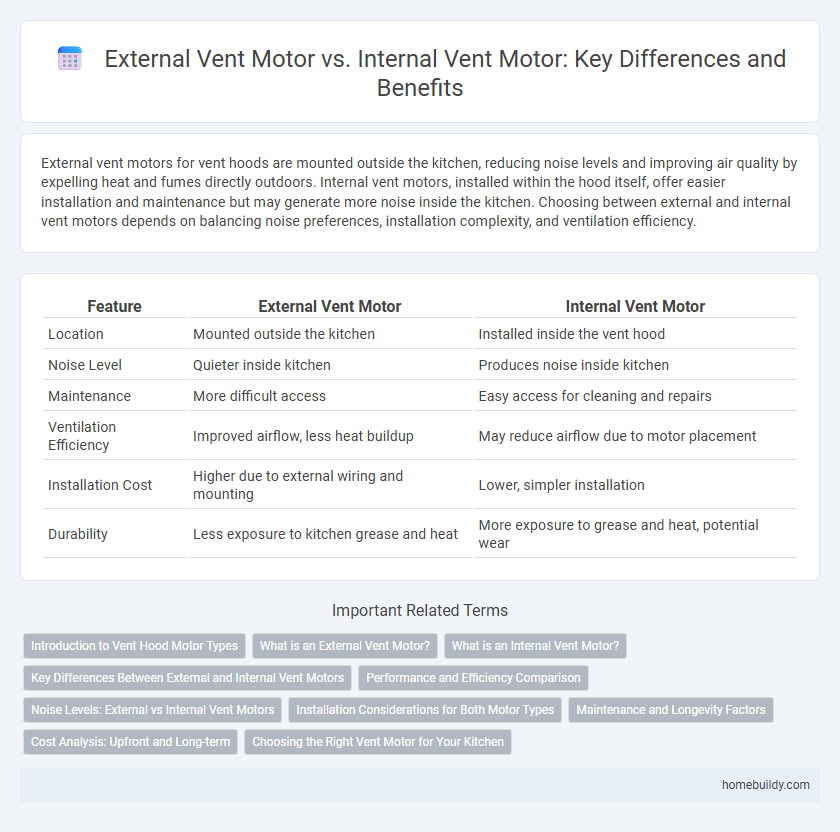External vent motors for vent hoods are mounted outside the kitchen, reducing noise levels and improving air quality by expelling heat and fumes directly outdoors. Internal vent motors, installed within the hood itself, offer easier installation and maintenance but may generate more noise inside the kitchen. Choosing between external and internal vent motors depends on balancing noise preferences, installation complexity, and ventilation efficiency.
Table of Comparison
| Feature | External Vent Motor | Internal Vent Motor |
|---|---|---|
| Location | Mounted outside the kitchen | Installed inside the vent hood |
| Noise Level | Quieter inside kitchen | Produces noise inside kitchen |
| Maintenance | More difficult access | Easy access for cleaning and repairs |
| Ventilation Efficiency | Improved airflow, less heat buildup | May reduce airflow due to motor placement |
| Installation Cost | Higher due to external wiring and mounting | Lower, simpler installation |
| Durability | Less exposure to kitchen grease and heat | More exposure to grease and heat, potential wear |
Introduction to Vent Hood Motor Types
Vent hood motor types are primarily categorized into external vent motors and internal vent motors, each designed to optimize kitchen ventilation efficiency. External vent motors are installed outside the kitchen area, reducing indoor noise levels and improving airflow while internal vent motors are integrated within the vent hood, offering compact design and easier installation. Choosing between external and internal vent motors depends on factors such as kitchen layout, noise preferences, and ventilation requirements for removing smoke, grease, and odors.
What is an External Vent Motor?
An external vent motor is a type of blower installed outside the kitchen, typically on the roof or an exterior wall, designed to efficiently expel cooking fumes and heat from the vent hood. This placement reduces noise and heat buildup inside the kitchen, improving overall ventilation performance. External vent motors are preferred for their durability and ability to handle higher airflow volumes compared to internal vent motors.
What is an Internal Vent Motor?
An internal vent motor is a component housed within the vent hood, responsible for drawing air through the cooking area and expelling it through the ductwork. It offers a more compact design, reducing external noise and improving kitchen aesthetics compared to external vent motors. Internal vent motors require proper maintenance to ensure efficient air extraction and prevent overheating.
Key Differences Between External and Internal Vent Motors
External vent motors are mounted outside the kitchen, reducing noise levels within the cooking area and enhancing airflow efficiency by expelling air directly outdoors. Internal vent motors are installed inside the hood, offering easier access for maintenance but often generating more noise and potential heat near the cooking surface. Choosing between external and internal vent motors depends on factors like kitchen layout, noise tolerance, and ventilation requirements.
Performance and Efficiency Comparison
External vent motors offer superior performance by reducing heat buildup inside the kitchen and maintaining quieter operation due to their placement outside the cooking area. Internal vent motors, while easier to install, tend to be less efficient as the motor generates heat and noise within the hood space, impacting overall kitchen comfort. Energy efficiency ratings often favor external motors, as their design minimizes airflow resistance and maximizes extraction power, leading to improved ventilation effectiveness.
Noise Levels: External vs Internal Vent Motors
External vent motors typically produce less noise inside the kitchen since the motor is located outside the living space, reducing indoor sound levels significantly. Internal vent motors, positioned within the hood housing, often generate louder operational noise directly in the cooking area, which can disrupt conversation and concentration. Choosing an external vent motor is ideal for noise-sensitive environments where quieter ventilation is essential.
Installation Considerations for Both Motor Types
External vent motors require careful placement outside the kitchen to minimize noise and heat inside, often demanding longer duct runs and weatherproof housing. Internal vent motors are installed within the hood unit, simplifying ductwork but necessitating robust insulation and vibration dampening to reduce sound and heat transfer. Proper electrical wiring and ventilation clearance must be assessed for both to ensure safe, efficient installation and optimal performance.
Maintenance and Longevity Factors
External vent motors typically offer easier maintenance due to their accessibility outside the home, allowing for quicker cleaning and replacement without disrupting indoor air quality. Internal vent motors, while more compact and quieter, often require more intricate disassembly for maintenance, potentially shortening their lifespan if not regularly serviced. Longevity is generally higher for external motors as they benefit from reduced exposure to indoor grease and moisture, which can degrade internal components faster.
Cost Analysis: Upfront and Long-term
External vent motors for vent hoods typically incur higher upfront installation costs due to additional ductwork and weatherproofing requirements but offer long-term savings through improved energy efficiency and reduced noise levels. Internal vent motors involve lower initial costs and simpler installation but may experience higher maintenance expenses and shorter lifespans due to indoor heat and grease exposure. Evaluating total cost of ownership highlights external motors as a more cost-effective option for heavy-duty or frequent use scenarios.
Choosing the Right Vent Motor for Your Kitchen
Choosing the right vent motor for your kitchen depends on factors like noise level, airflow efficiency, and installation space. External vent motors are typically quieter since they are mounted outside the kitchen, reducing indoor noise but requiring ductwork to the exterior. Internal vent motors are easier to install and maintain within the hood but may produce more noise and require higher-quality components to ensure efficient ventilation.
External vent motor vs Internal vent motor Infographic

 homebuildy.com
homebuildy.com